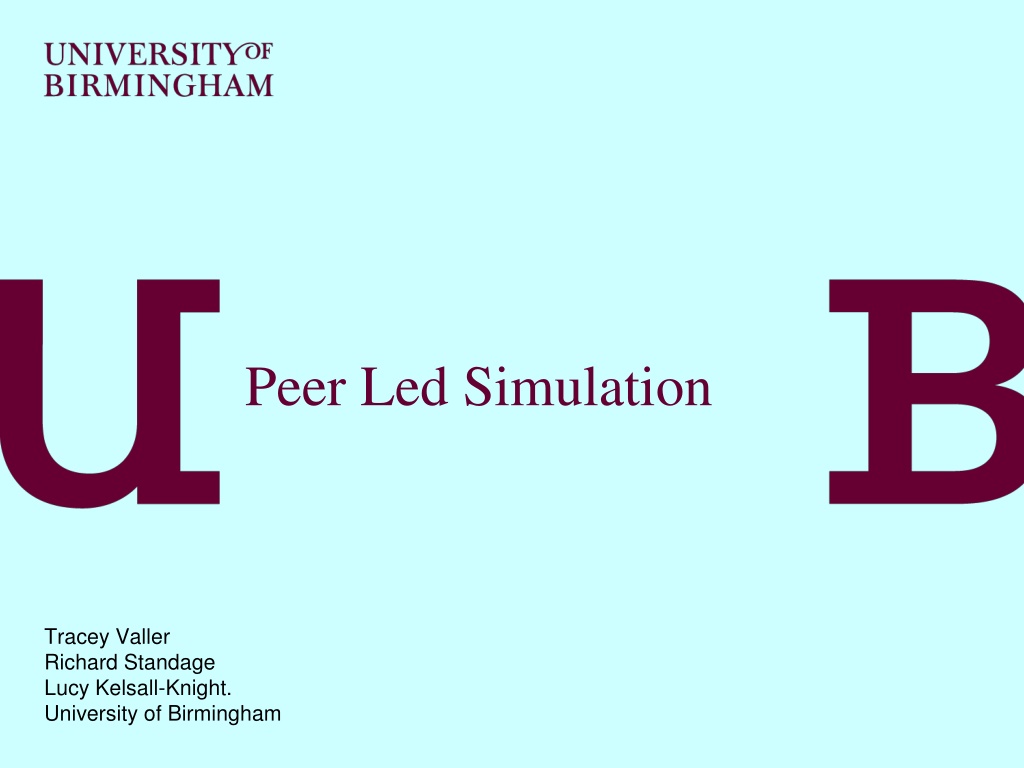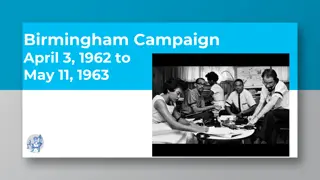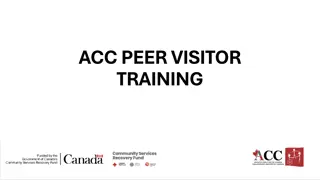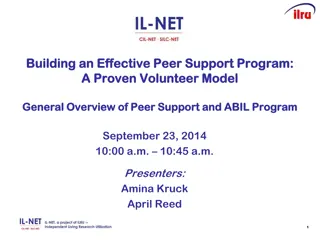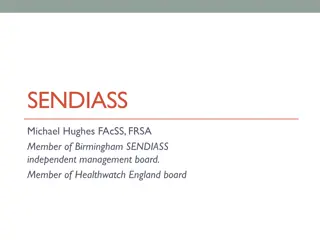Peer-Led Simulation in Nursing Education at University of Birmingham
Simulation, particularly student-led, plays a crucial role in nursing education at the University of Birmingham, focusing on the Children's Critical Care module. Students create detailed scenarios, plan interventions, and facilitate simulations to enhance learning and clinical skills in a safe environment. Evaluation reveals positive outcomes with themes of confidence, teamwork, knowledge acquisition, and research skills emerging from student feedback.
Download Presentation

Please find below an Image/Link to download the presentation.
The content on the website is provided AS IS for your information and personal use only. It may not be sold, licensed, or shared on other websites without obtaining consent from the author. Download presentation by click this link. If you encounter any issues during the download, it is possible that the publisher has removed the file from their server.
E N D
Presentation Transcript
Peer Led Simulation Tracey Valler Richard Standage Lucy Kelsall-Knight. University of Birmingham
Simulation Simulation is an established component of nurse education. It has the dual benefits of easing the pressure on clinical placements (Opton et al 2014) and providing a safe environment to learn and develop clinical skills and decision making (Cant and Cooper 2017). A more innovative aspect of this technique is student led simulation (Valler-Jones 2014).
Peer Led Simulation As part of the Children s Critical Care module in the Bachelor of Nursing programme at the University of Birmingham, student led simulation were used as a way of facilitating students to learn some of the module content and giving them hands on practice of clinical skills in a safe environment. This is a continuation of a study by Valler- Jones (2014)
Childrens Critical Care Module The module content covers the management and care of neonates, children and young people in high dependency and critical care settings. Typical conditions include prematurity, organ dysfunction, trauma and head injury, respiratory compromise or failure, sepsis, thermal injuries or other potentially life threatening illnesses or events.
Peer Led Simulation Students were divided into groups of 5/6 to; Devise a detailed clinical scenario based on a condition of their choice. Plan the nursing interventions required to manage the patient in their scenario, based on current evidence and recommended best practice. Include any medical equipment that would be needed to assess and manage the patient.
Peer Led Simulation Each group facilitated their own clinical simulation for another group, providing prompts to enable them to respond to the situation and manage the child as appropriate The group not involved in that simulation observed and provided feed back. All students had the opportunity to facilitate, be facilitated and provide feedback All scenarios were supervised by a member of the academic team to ensure adherence to safe, effective practice.
Evaluation Based on Module evaluation, Pre and Post Intervention questionnaire and single and focus group interviews over last 7 years (N= 123 students) Largely positive. Some themes from data (relating to PLS and not simulation overall) Confidence Learning from Peers/Team Working Knowledge base and Research skills Anxiety/Stress
Free Comments. Confidence Increased my confidence as it enabled me to revisit areas and reinforce the knowledge that was there Able to ask questions and seek explanations Competent but still a lot to learn Getting the chance to practice with the dummies so that I feel confident enough to actually do it. Gave me chance to have lots of attempts until I felt comfortable with it. Made me learn it better. Practicing skills in a safe environment. Solidified taught elements of the module.
Free Comments. Learning from Peers Helped develop my assessment of patients The groups chose different scenarios which increased overall knowledge Understand more of the care needs of high dependency patients. I didn t get anxious as you are with your peers and everyone knows different bits of information so they are there to support you and can provide information Beneficial to practice in a safe environment Still require real life practice to be fully competent.
Free Comments. Team working Able to further develop team working skills by negotiating tasks. Doing more sessions like this would have had a positive effect on team working. Working as a team has helped me collate my knowledge and ideas. We are all there for each other. It was not a competition
Feedback. Knowledge and Research We all had different experiences and knowledge but it also meant they went and researched further into this to catch up. The experience was shared All groups had to prepare using policies/guidelines and research . Researching the scenario meant I read lots of research papers which strengthened my evidence based practice .
Free Comments. Anxiety/Stress What if I let my group down? As a group you supported each other so that made it easier but definitely stressful nervewracking You are expert of that simulation so expectation is high. It was dramatic. We were dramatic!
Conclusions/recommendations Valued and appreciated by students. Multiple benefits to clinical skills and life long learning Enabled them to apply the taught theoretical components of the module. More or longer sessions would have enhanced their learning to a greater extent. Incorporate into future iterations of module.
References Cant, R.P. and Cooper, S.J. (2017) Use of simulation- based learning in undergraduate nurse education: An umbrella systematic review, Nurse Education Today, 49, pp. 63-71. doi: 10.1016/j.nedt.2016.11.015. Opton, L., Wilkinson, C., and Davenport, L. (2014). Student-developed simulations: an innovative approach to teaching and learning. Clinical Simulation in Nursing, 10, e103-e106. Valler-Jones, T. (2014). The impact of peer-led simulations on student nurses. British Journal of Nursing, 23(6), p321-326
